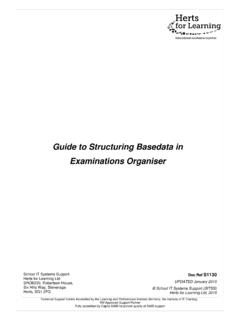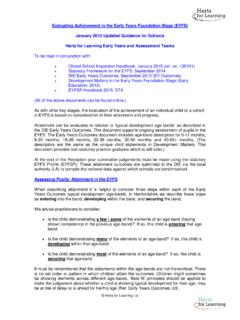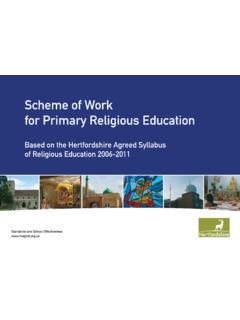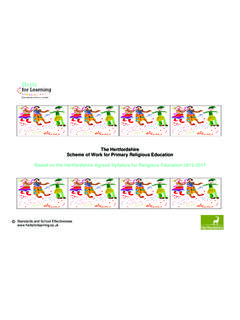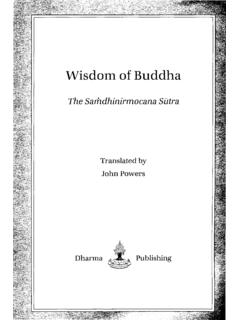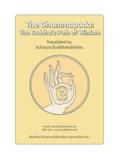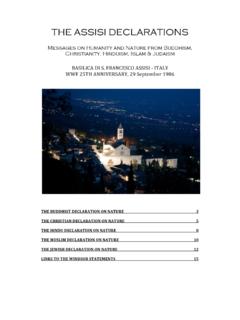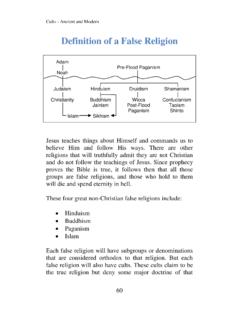Transcription of The hertfordshire scheme of work for secondary religious ...
1 Herts for Learning Ltd The hertfordshire scheme of work for secondary religious Education Copyright of this publication and copyright of individual documents and media within this publication remains with the original publishers and is intended only for use in schools. All rights reserved. Extracts of the materials contained on this publication may be used and reproduced for educational purposes only. Any other use requires the permission of the relevant copyright holder. Requests for permissions, with a statement of the purpose and extent, should be addressed to: Sarah Gatfield, Support Officer, at 1.
2 INTRODUCTION The hertfordshire secondary scheme of work for religious Education (RE) has been developed to accompany the hertfordshire Agreed Syllabus for religious Education 2012-2017. It is not a legal requirement to plan RE using this document, but if you do so, your school will be meeting the statutory requirements of the Agreed Syllabus. This scheme of work provides a model for teaching and learning in Key Stage 3 religious Education. It is not necessary to follow it in the order it appears on these pages.
3 Some Heads of Departments may wish to adapt the order or substitute suggested activities with successful units from their existing planning. The important factors to consider when making any changes are that: all parts of the Programmes of Study from the Agreed Syllabus must be taught: (Agreed Syllabus pages 23-25, ) Christianity at each Key Stage; the six principal religions in greater depth through key stages 3 and 4 and post-16. The Learning Objectives have been designed to ensure that students reach appropriate levels at the end of Key Stage 3.
4 Changes to the content will necessitate changes to the Learning Objectives and consequently changes to the tasks set. The model Funding Agreement for new Academies (2010) follows this stipulation that RE should be taught in all schools, following a local Agreed Syllabus or denominational syllabus. The law for Free Schools is the same as that for new Academies. In Voluntary Aided Schools with a religious character there is no requirement to teach RE according to the Agreed Syllabus. The required provision for RE is either: according to the trust deed of the school or according to the tenets of the religion or religious denomination (where provision is not specified in the trust deed) or according to the hertfordshire Agreed Syllabus where parents request it (if a child cannot reasonably attend a school where the Agreed Syllabus is being taught).
5 2. THE EIGHT LEVEL SCALE OF ATTAINMENT The Eight Level Scale of Attainment in the Agreed Syllabus has been used to frame the Learning Objectives in the Units of work . Assessment has two main functions: as a guide to planning ( assessment for learning); and in order to summarise what a pupil has learned ( assessment of learning). The former should be used at all times to inform planning. The latter will be used more regularly when report writing or preparing for consultation meetings with parents. 1 3. AMPLIFICATION OF STATEMENTS OF ATTAINMENT The following exemplars are taken from the primary scheme of work , levels 4 and 5 also provide guidance for KS3.
6 The Eight Level Scale of Attainment in the Agreed Syllabus has been used to frame the Learning Objectives in the Units of work . Assessment has two main functions: as a guide to planning ( assessment for learning); and in order to summarise what a pupil has learned ( assessment of learning). The former should be used at all times to inform planning. The latter will be used more usually when report writing or preparing for consultation meetings with parents. The levels are consistent with subjects from the National Curriculum.
7 The levels are reprinted here as a grid, detailing the Attainment Targets and separating them into the Six Key Areas of religious Education which are the basis for the Programmes of Study. The examples printed in italic, provide amplification to the statements of attainment, in order to clarify the nature of work which students might produce at each level. AT1 Learning about religion knowledge and understanding of AT2 Learning from religion response, reflection, evaluation and application to questions of Level Beliefs and teachings religious practices and lifestyles Ways of expressing meaning Human identity, personality and experience Questions of meaning and purpose Values and commitments EYFS Listen and respond to religious stories.
8 Communicate through talk or gesture about a range of special objects/places/ people/practices. Use some basic religious vocabulary that reflects the breadth of their experience. Show awareness of things and people that matter to them and link this to learning in RE. Show curiosity and interest in the world around them. Understand what is right, what is wrong and why. Examples Of RE at EYFS Using nativity figures, props or costumes, play out the Christmas story. Looking at a range of precious items, including those that are religious , talk about how to treat them with respect.
9 Role play a religious ceremony using appropriate religious language. Draw a picture of a person, animal or object which they love and explain how they make them feel. As seasons change discuss how this could have happened. When listening to a faith story give responses to situations of right and wrong. 2 Level Beliefs and teachings religious practices and lifestyles Ways of expressing meaning Human identity, personality and experience Questions of meaning and purpose Values and commitments L1 Recount elements of religious stories.
10 Recognise religious objects/places/ people/practices. Recognise some religious symbols and use some religious vocabulary correctly. Express their own experiences and feelings, recognising what is important in their own lives. Recognise interesting/ puzzling aspects of life. In relation to matters of right and wrong, express what is of value and concern to themselves and others. Examples Of RE at Level 1 Re-enact the story of Noah and the Ark and talk about the importance of the message of the rainbow for some believers.
